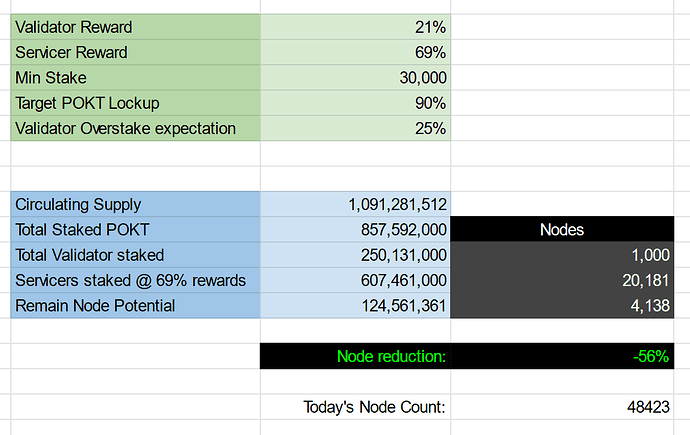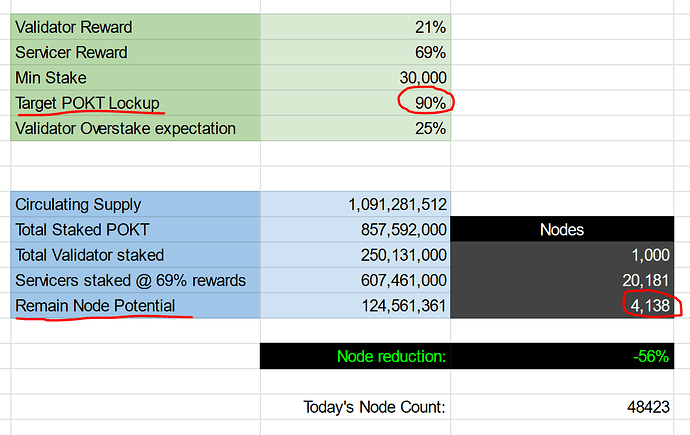UPDATED: Calculations have been updated. Target ProposerAllocation is now 21% instead of 27%. This change due to an over calculation I discovered when refining the numbers. Feel free to check out the formula here.
Attributes
- Author(s): @shane
- Parameter: ProposerAllocation, ServicerAllocation, MinimumStake
- Current Value: ProposerAllocation = 1%, ServicerAllocation = 89%, MinimumStake = 15000
- New Value: ProposerAllocation = 21%, ServicerAllocation = 69%, MinimumStake = 30000
Summary
Securing the network, reducing network infrastructure, and continuing to reduce inflation are currently top priories of the DAO.
GOOD VIBES seeks to address these challenges with a new economic framework that centralizes decision making and prioritizes validators. However I believe our challenges can be addresses while preserving our current ecosystem model with significantly less risk.
Core-devs saw ahead when designing pocket-core and knew the network needed parameters to account for ecosystem conditions. We already have all the parameters we need to address today’s challenges in a safe and effective way, so I propose we use them.
THE PHASE PLAN
I am proposing a 2 phase approach:
Security Phase:
- Block producer reward increase
- Minimum stake increase
Optimization Phase:
- Lite client
- Inflation adjustment (akin to WAGMI).
Motivation/Rationale
Phase 1: Security Phase
The Security Phase needs to happen now. We need to secure the network by increasing block production rewards. Any changes to the block producer rewards will create an unstaking event where large numbers of servicers need to unstake to consolidate POKT to create a validators. With there needing to be an unstaking event already, I suggest we also increase the minimum stake required for to run servicers as well.
Why change minimum stake? It will reduce the number of nodes on the network while the lite client is under development. By incentivizing node consolidation on both the validation level and servicer level, we can reduce the number of nodes on the network by 55% while securing the network from validation attacks.
PARAMETER CHANGES
Validation Rewards: 21% (Currently at 1%)
Servicer Rewards: 69% (Currently at 89%)
Minimum Stake: 30,000 (Currently at 15,000)
RESULTS
- Network secured with 26% of POKT staked in validation
- Node count and network wide infrastructure costs cut by more than 50%
- If 90% of circulating POKT is staked into nodes, the most amount of nodes on the network would be less than 26k (we will never have 48k+ nodes on the network until potentially after v1)
TRANSITION EVENT
Similar to what GOOD VIBES proposed, we would likely need an unstake transition event to give nodes the ability to consolidate into validators and servicers without going through the 3 week unstaking period.
From GOOD VIBES ![]()
Phase 2: Optimization Phase
Once the network is secured and network wide infrastructure costs have been dramatically reduced, we are in a good place to further introduce further optimizations.
LITE CLIENT
Thunderhead and POKTfund’s v0 contributions have kicked off the potential for a lite client which could even further reduce network wide infrastructure costs. They will be working with core-dev to finish the prototype, QA, and hopefully bring to market. The core-devs have already created their own code-complete prototype which has proven it’s initial viability.
Once the lite client feature is added to pocket-core, then we are in a solid place to optimize inflation without crushing node runners.
INFLATION ADJUSTMENT
With the network already being significantly optimized by reducing the number of node, and having a lite client feature, we can continue initiatives like WAGMI to find the sweet spot for inflation while the core-team is building app staking into the Portal. The inflaton goals outlined by @adam in GOOD VIBES could be optainable without fundamentally changing Pocket’s economics model.
The benefit of doing inflation adjustment at this point is we will have real data on how these new optimizations have effected the network. Adjustment can be made with real world data instead of using projections. Decisions can be made that consider and protect both validators and servicers.
GROWTH POTENTIAL
One of the benefits of this approach, is there is still room for healthy node growth. By reducing the number of nodes on the the network, and making them cheaper than ever to run with the lite client, there will be ample reasons why folks would still want to join the Pocket node ecosystem.
By increasing the minimum stake parameter to 30k POKT, the network will only have 4k more available nodes (when looking at the circulating supply).
This could be leveraged to generate excitement and encourage folks to purchase Pocket nodes.
“Right now Pocket has a max node count of 26k and there are only 4k spots left!”
Currently 78% of circulating POKT is staked into nodes and why not shoot for 90% (especially since POKT is designed for higher inflation)? That would put circulation supply in a good position for when app staking is released.
Dissenting Opinions
Increasing minimum stake would cut off those who only run 1 POKT node.
Yes, this is a fair critique and a concern. Currently there are around 80 single node operators. These users would likely need to top off their nodes to continue generating revenue with a single node. Fortunately POKT is the most affordable it’s ever been so topping off now could be within reach for many.
There are upwards of 1000 single node customers using node hosting services. These node owners are also in a predicament when increasing the minimum stake. However, fortunately Pocket is a robust ecosystem with services that offer node pooling. This means that these users have options to simply change from one service to another.
We are in the unfortunate position where any change to the network effects users in different ways. Whether it’s cutting servicer rewards (like GOOD VIBES suggested) or increasing minimum stake, changes will always hit folks differently. Please respond to this post with concerns on how any of these changes may effect you.
We should be targeting a max of 15k nodes on the network.
I haven’t agreed with the 15k figure since it was introduced. Pocket was created on the idea that we would eventually have hundreds of thousands of nodes, and while we have limitation with v0, I don’t think we should forcefully regulate node count to a set number.
15k is as arbitrary to the 20k I’m suggesting. With the strategy of increasing minimum stake we have a clear cap on the amount of nodes that can be staked with our current circulating supply. I feel it is much more elegant to have a natural node cap vs a regulated cap.
Mechanisms like GOOD VIBES make Pocket’s economics significantly more complex, especially for new users trying to enter into our economics. I think we need our economics to be approachable (which it has been) so I suggest we take advantage of the tools we were given for this exact situation and keep things moving forward.
We need to move faster on all these areas, and doing a phased approach is too slow.
With just the Security Phase we can address our most pressing needs in a very quick fashion. We don’t need to build anything other than plan a Grace Period which would need to be part of any solution we take.
To tackle every need of the network, I think we need a progressive plan that can be taken one step at a time. It has taken years to get us to where we are today, and making huge sweeping changes is a major security and economic risk.
We should focus on weighted staking for node consolidation instead of increasing the minimum stake.
I am all for weighted stake and I believe that concept would be the best solution. Unfortunately weighted stake is a very complex feature that will take notable time to develop, test, and deliver. Weighted stake would need to be a network fork.
Pocket CTO @luyzdeleon talked about the technical challenges that will need to be overcome before weighted stake will be a reality.
I believe most of the community is looking for a more immediate solutions than what weighted stake can supply. The Phase Plan still keeps the option for weighted stake possible since it isn’t changing Pocket’s economic model to be validator focused.
Requiring an unstaking event is risky.
So far, every solution in these discussions require unstaking. A coordinated consolidation event is going to be required regardless and since most nodes are controlled by 3rd party hosting services, coordinating the transition is very possible with PNI’s support.
Analyst(s)
Shane Burgett (@shane)
Copyright
Copyright and related rights waived via CC0.


